Page 44 of 678
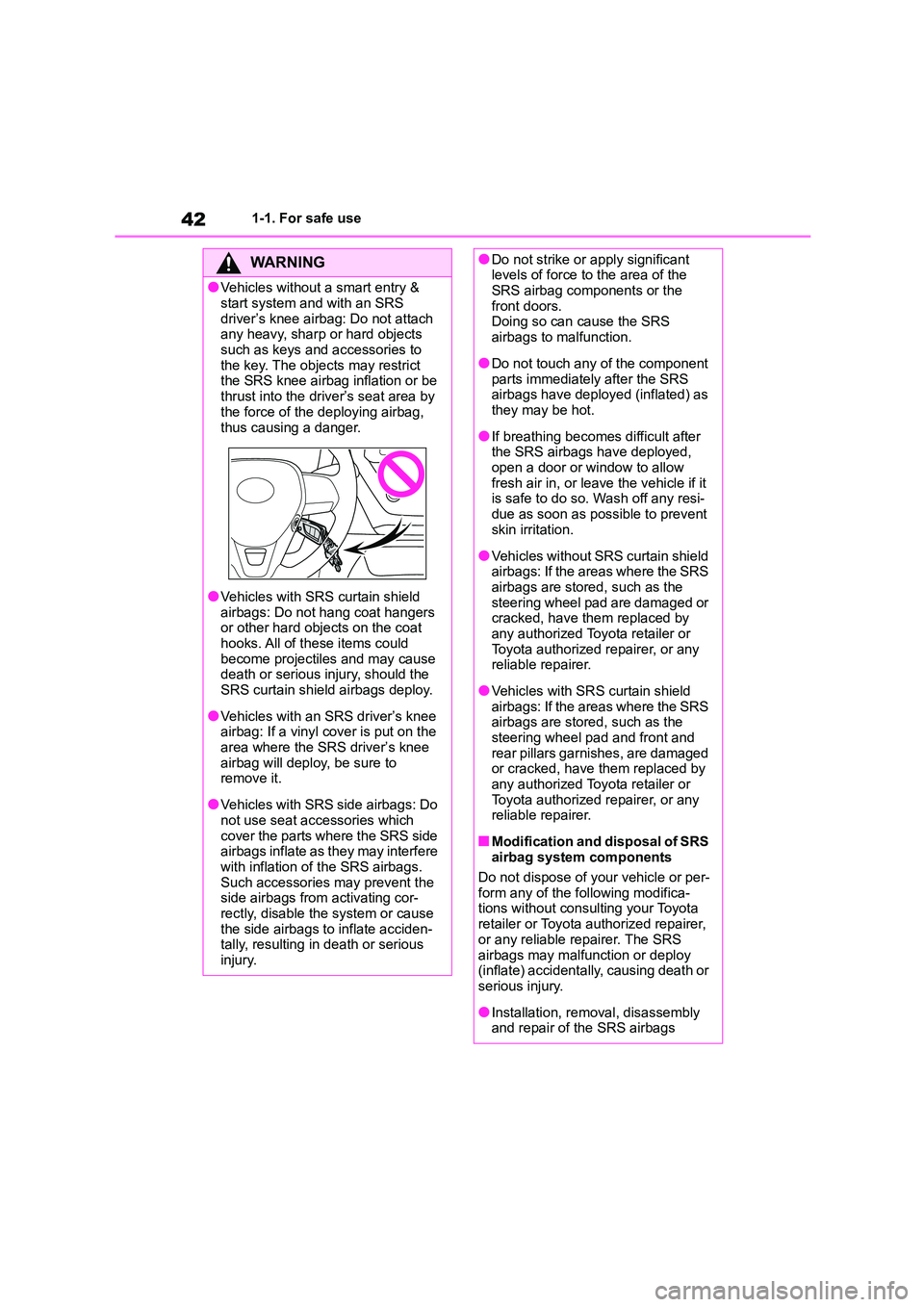
421-1. For safe use
WA R N I N G
●Vehicles without a smart entry &
start system and with an SRS
driver’s knee airbag: Do not attach any heavy, sharp or hard objects
such as keys and accessories to
the key. The objects may restrict the SRS knee airbag inflation or be
thrust into the driver’s seat area by
the force of the deploying airbag,
thus causing a danger.
●Vehicles with SRS curtain shield
airbags: Do not hang coat hangers or other hard objects on the coat
hooks. All of these items could
become projectiles and may cause death or serious injury, should the
SRS curtain shield airbags deploy.
●Vehicles with an SRS driver’s knee
airbag: If a vinyl cover is put on the
area where the SRS driver’s knee airbag will deploy, be sure to
remove it.
●Vehicles with SRS side airbags: Do
not use seat accessories which
cover the parts where the SRS side airbags inflate as they may interfere
with inflation of the SRS airbags.
Such accessories may prevent the side airbags from activating cor-
rectly, disable the system or cause
the side airbags to inflate acciden- tally, resulting in death or serious
injury.
●Do not strike or apply significant levels of force to the area of the
SRS airbag components or the
front doors. Doing so can cause the SRS
airbags to malfunction.
●Do not touch any of the component
parts immediately after the SRS
airbags have deployed (inflated) as they may be hot.
●If breathing becomes difficult after the SRS airbags have deployed,
open a door or window to allow
fresh air in, or leave the vehicle if it is safe to do so. Wash off any resi-
due as soon as possible to prevent
skin irritation.
●Vehicles without SRS curtain shield
airbags: If the areas where the SRS airbags are stored, such as the
steering wheel pad are damaged or
cracked, have them replaced by any authorized Toyota retailer or
Toyota authorized repairer, or any
reliable repairer.
●Vehicles with SRS curtain shield
airbags: If the areas where the SRS airbags are stored, such as the
steering wheel pad and front and
rear pillars garnishes, are damaged or cracked, have them replaced by
any authorized Toyota retailer or
Toyota authorized repairer, or any reliable repairer.
■Modification and disposal of SRS airbag system components
Do not dispose of your vehicle or per-
form any of the following modifica- tions without consulting your Toyota
retailer or Toyota authorized repairer,
or any reliable repairer. The SRS
airbags may malfunction or deploy (inflate) accidentally, causing death or
serious injury.
●Installation, remo val, disassembly
and repair of the SRS airbags
Page 47 of 678
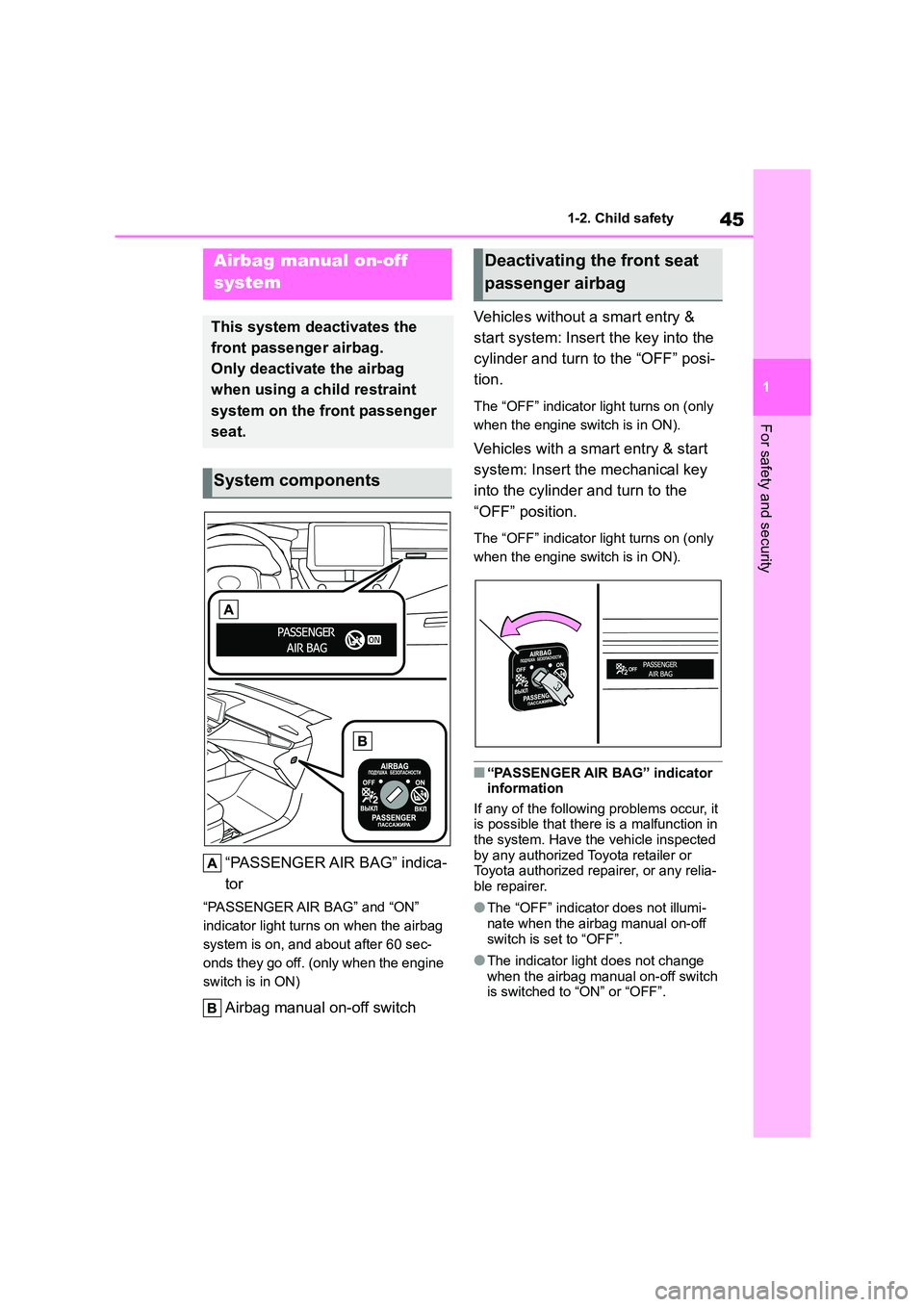
45
1
1-2. Child safety
For safety and security
1-2.Child safety
“PASSENGER AIR BAG” indica-
tor
“PASSENGER AIR BAG” and “ON”
indicator light turns on when the airbag
system is on, and about after 60 sec-
onds they go off. (only when the engine
switch is in ON)
Airbag manual on-off switch
Vehicles without a smart entry &
start system: Insert the key into the
cylinder and turn to the “OFF” posi-
tion.
The “OFF” indicator light turns on (only
when the engine switch is in ON).
Vehicles with a smart entry & start
system: Insert the mechanical key
into the cylinder and turn to the
“OFF” position.
The “OFF” indicator light turns on (only
when the engine switch is in ON).
■“PASSENGER AIR BAG” indicator information
If any of the following problems occur, it
is possible that there is a malfunction in the system. Have the vehicle inspected
by any authorized Toyota retailer or
Toyota authorized repairer, or any relia- ble repairer.
●The “OFF” indicator does not illumi-
nate when the airbag manual on-off switch is set to “OFF”.
●The indicator light does not change when the airbag manual on-off switch
is switched to “ON” or “OFF”.
Airbag manual on-off
system
This system deactivates the
front passenger airbag.
Only deactivate the airbag
when using a child restraint
system on the front passenger
seat.
System components
Deactivating the front seat
passenger airbag
Page 48 of 678
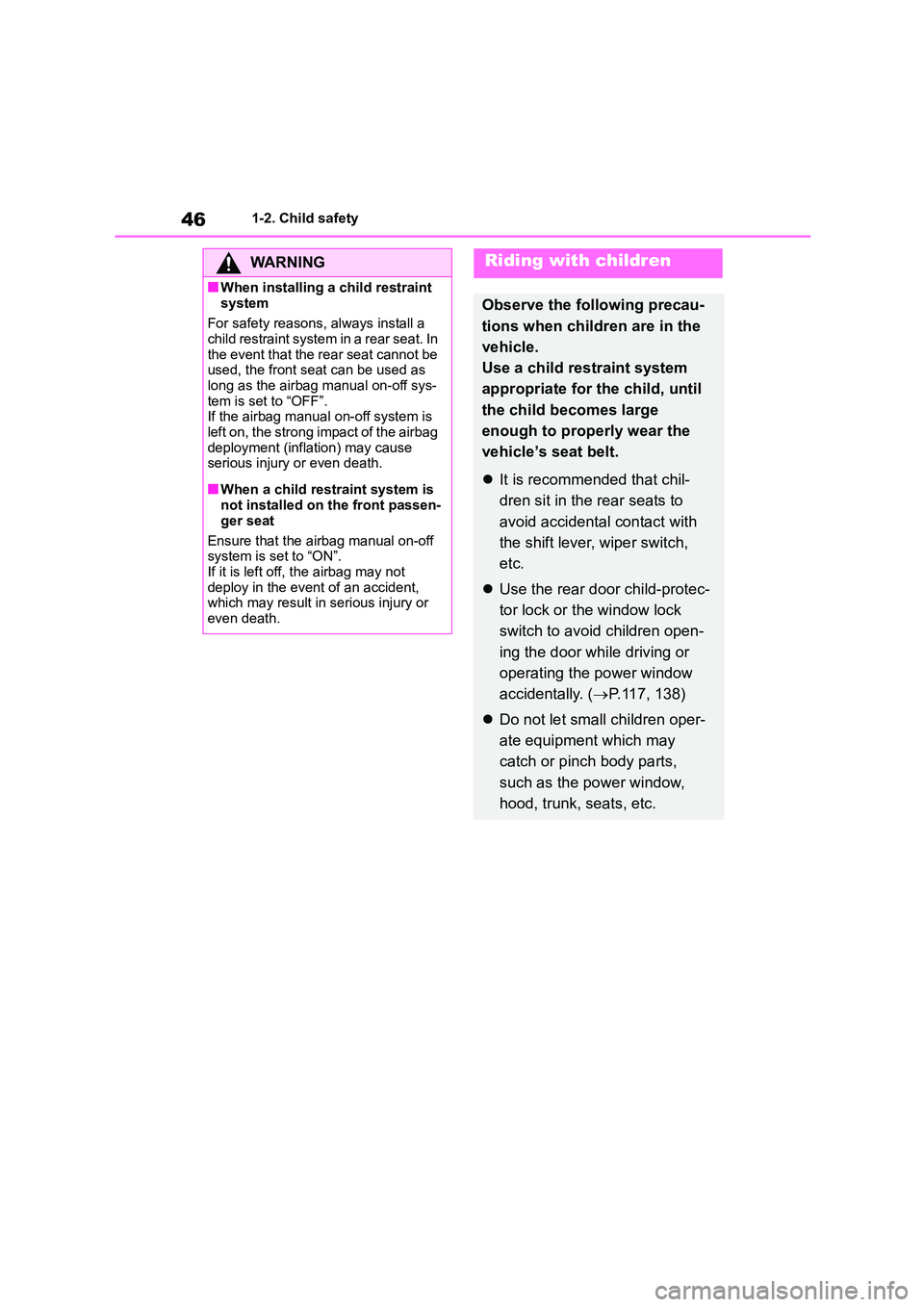
461-2. Child safety
WA R N I N G
■When installing a child restraint
system
For safety reasons, always install a child restraint system in a rear seat. In
the event that the rear seat cannot be
used, the front seat can be used as long as the airbag manual on-off sys-
tem is set to “OFF”.
If the airbag manual on-off system is
left on, the strong impact of the airbag deployment (inflation) may cause
serious injury or even death.
■When a child restraint system is
not installed on the front passen-
ger seat
Ensure that the airbag manual on-off
system is set to “ON”.
If it is left off, the airbag may not deploy in the event of an accident,
which may result in serious injury or
even death.
Riding with children
Observe the following precau-
tions when children are in the
vehicle.
Use a child restraint system
appropriate for the child, until
the child becomes large
enough to properly wear the
vehicle’s seat belt.
It is recommended that chil-
dren sit in the rear seats to
avoid accidental contact with
the shift lever, wiper switch,
etc.
Use the rear door child-protec-
tor lock or the window lock
switch to avoid children open-
ing the door while driving or
operating the power window
accidentally. ( P.117, 138)
Do not let small children oper-
ate equipment which may
catch or pinch body parts,
such as the power window,
hood, trunk, seats, etc.
Page 52 of 678
501-2. Child safety
WA R N I N G
●Never use a rear-facing child
restraint system on the front pas-
senger seat when the airbag man- ual on-off switch is on. ( P.45) The
force of the rapid inflation of the
front passenger airbag can cause death or serious injury to children in
the event of an accident.
●There is a label(s) on the passen- ger side sun visor, indicating it is
forbidden to attach a rear-facing
child restraint system to the front passenger seat.
Details of the label(s) are shown in
the illustration below.
Page 53 of 678
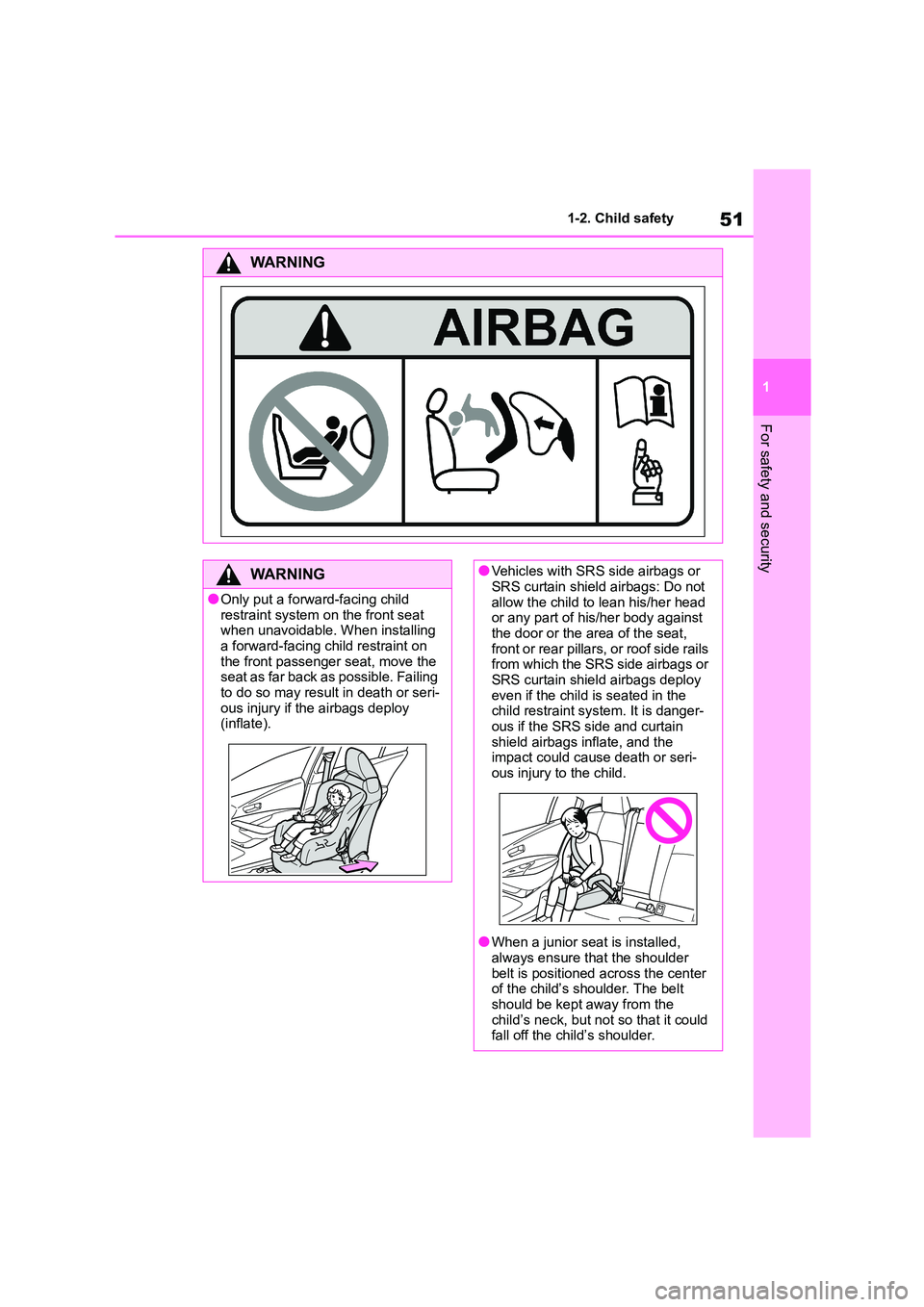
51
1
1-2. Child safety
For safety and security
WA R N I N G
WA R N I N G
●Only put a forward-facing child
restraint system on the front seat
when unavoidable. When installing a forward-facing child restraint on
the front passenger seat, move the
seat as far back as possible. Failing to do so may result in death or seri-
ous injury if the airbags deploy
(inflate).
●Vehicles with SRS side airbags or
SRS curtain shield airbags: Do not
allow the child to lean his/her head or any part of his/her body against
the door or the area of the seat,
front or rear pillars, or roof side rails
from which the SRS side airbags or SRS curtain shield airbags deploy
even if the child is seated in the
child restraint system. It is danger- ous if the SRS side and curtain
shield airbags inflate, and the
impact could cause death or seri- ous injury to the child.
●When a junior seat is installed, always ensure that the shoulder
belt is positioned across the center
of the child’s shoulder. The belt should be kept away from the
child’s neck, but not so that it could
fall off the child’s shoulder.
Page 56 of 678
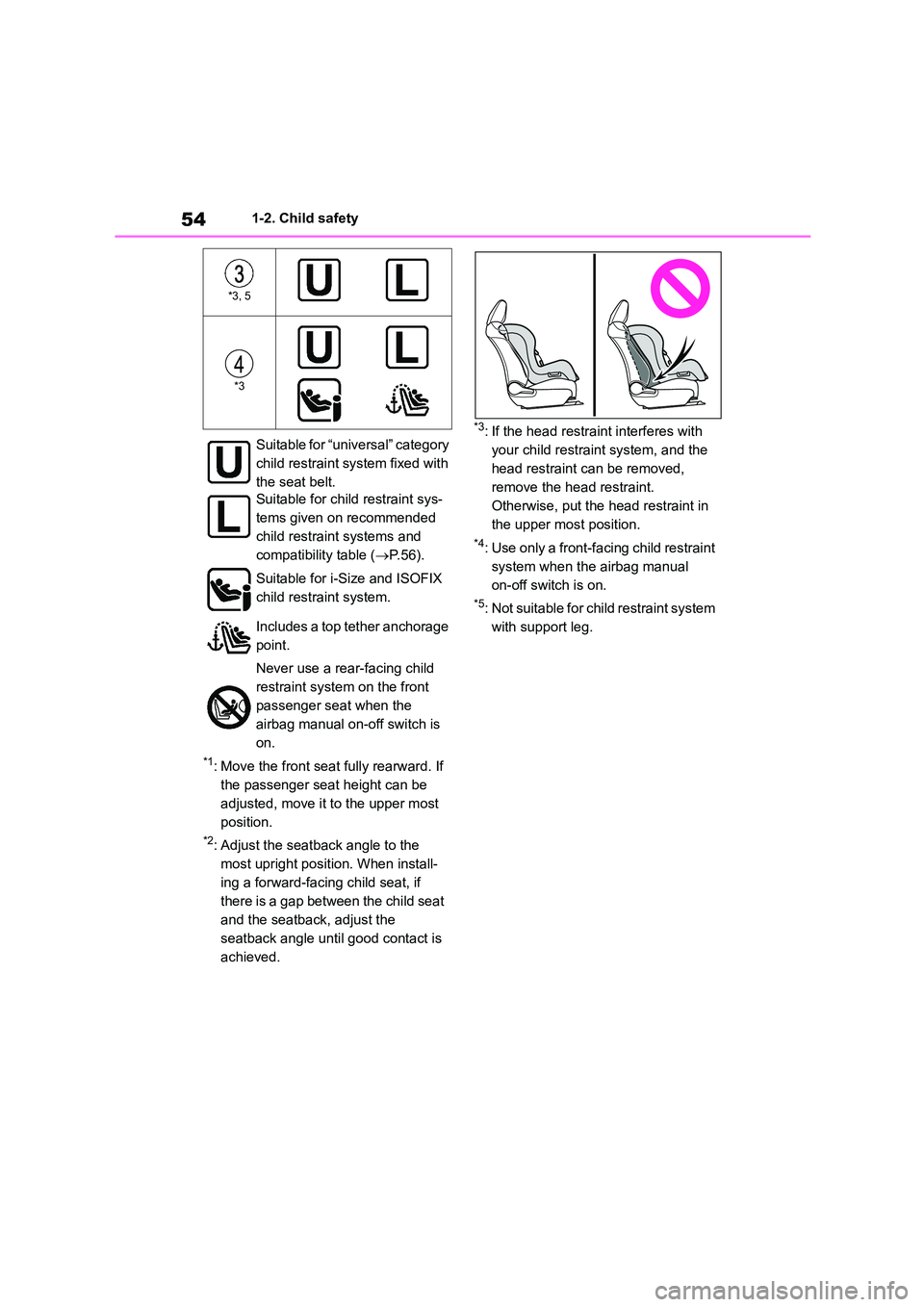
541-2. Child safety
*1: Move the front seat fully rearward. If
the passenger seat height can be
adjusted, move it to the upper most
position.
*2: Adjust the seatback angle to the
most upright position. When install-
ing a forward-facing child seat, if
there is a gap between the child seat
and the seatback, adjust the
seatback angle until good contact is
achieved.
*3: If the head restraint interferes with
your child restra int system, and the
head restraint can be removed,
remove the head restraint.
Otherwise, put the head restraint in
the upper most position.
*4: Use only a front-fa cing child restraint
system when the airbag manual
on-off switch is on.
*5: Not suitable for ch ild restraint system
with support leg.
*3, 5
*3
Suitable for “universal” category
child restraint syst em fixed with
the seat belt.
Suitable for child restraint sys-
tems given on recommended
child restraint systems and
compatibility table ( P. 5 6 ) .
Suitable for i-Size and ISOFIX
child restraint system.
Includes a top tether anchorage
point.
Never use a rear-facing child
restraint system on the front
passenger seat when the
airbag manual on-off switch is
on.
Page 57 of 678
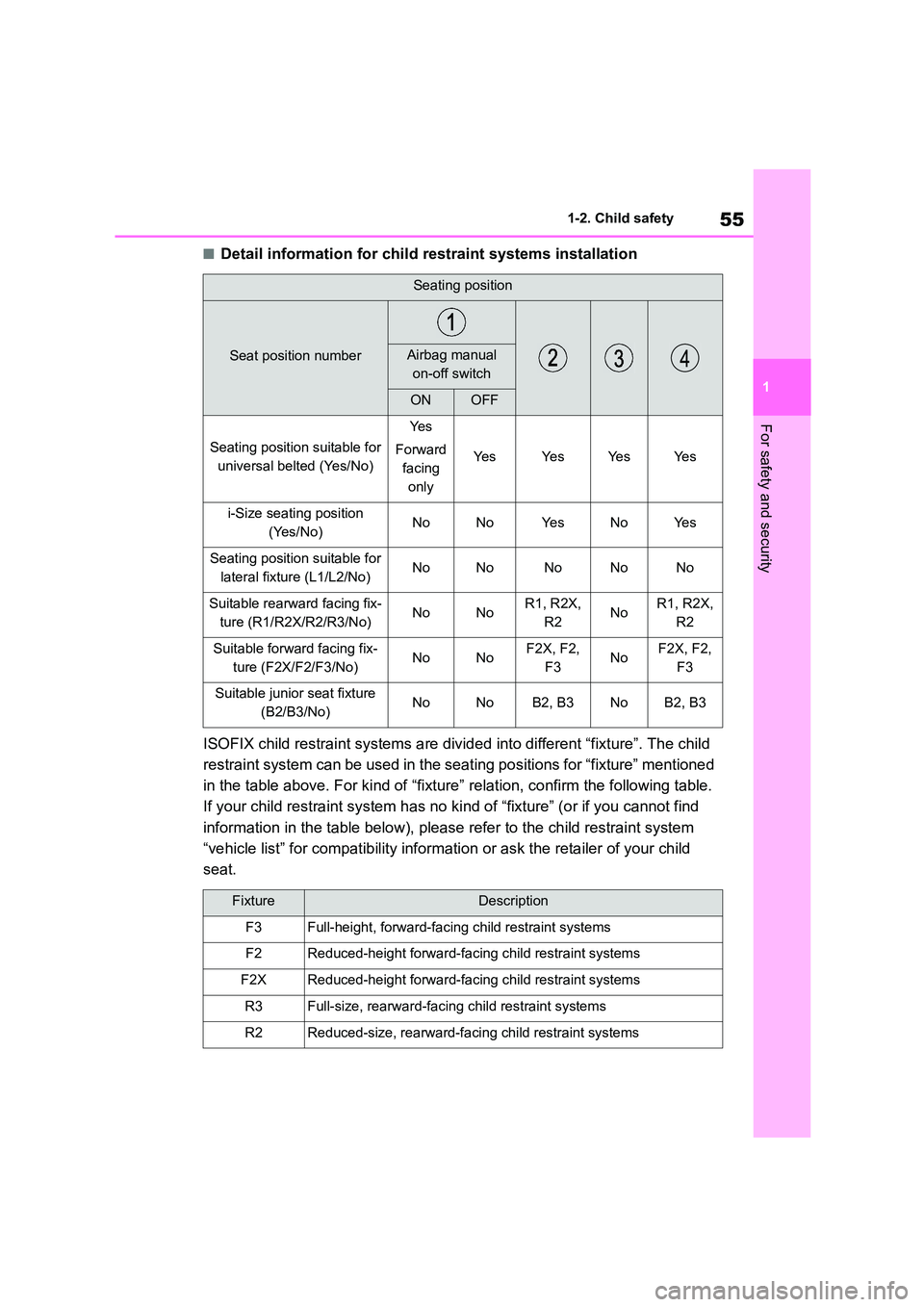
55
1
1-2. Child safety
For safety and security
■Detail information for child restraint systems installation
ISOFIX child restraint systems are divid ed into different “fixture”. The child
restraint system can be used in the se ating positions for “fixture” mentioned
in the table above. For kind of “fixtu re” relation, confirm the following table.
If your child restraint system has no ki nd of “fixture” (or if you cannot find
information in the table below), please refer to the child restraint system
“vehicle list” for compatib ility information or ask the retailer of your child
seat.
Seating position
Seat position numberAirbag manual
on-off switch
ONOFF
Seating position suitable for
universal belted (Yes/No)
Ye s
Forward
facing
only
Ye sYe sYe sYe s
i-Size seating position
(Yes/No)NoNoYe sNoYe s
Seating position suitable for
lateral fixture (L1/L2/No)NoNoNoNoNo
Suitable rearward facing fix-
ture (R1/R2X/R2/R3/No)NoNoR1, R2X,
R2NoR1, R2X,
R2
Suitable forward facing fix-
ture (F2X/F2/F3/No)NoNoF2X, F2,
F3NoF2X, F2,
F3
Suitable junior seat fixture
(B2/B3/No)NoNoB2, B3NoB2, B3
FixtureDescription
F3Full-height, forward-faci ng child restraint systems
F2Reduced-height forward-facing child restraint systems
F2XReduced-height forward-facing child restraint systems
R3Full-size, rearward-facing child restraint systems
R2Reduced-size, rearward-facing child restraint systems
Page 58 of 678
561-2. Child safety
■Recommended child restraint systems and Compatibility table
R2XReduced-size, rearward-facing child restraint systems
R1Rearward-facing infant seat
L1Left lateral-facing (carrycot) infant seat
L2Right lateral-facing (carrycot) infant seat
B2Junior seat
B3Junior seat
Mass groupsRecommended Child
Restraint System
Seating position
Airbag man-
ual on-off
switch
ONOFF
0, 0+
Up to 13 kg (28
lb.)
G0+, BABY SAFE
PLUS (Yes/No)NoYe sYe sYe sYe s
G0+ BABY SAFE
PLUS with SEAT
BELT FIXATION,
BASE PLATFORM
(Yes/No)
NoYe sYe sNoYe s
TOYOTA MINI
(Yes/No)NoYe sYe sYe sYe s
TOYOTA MIDI
(Yes/No)NoNoYe sNoYe s
TOYOTA MINI with
ISO-BASE (Yes/No)NoNoYe sNoYe s
I
9 to 18 kg (20
to 39 lb.)
TOYOTA DUO PLUS
(Yes/No)
Ye s
Belt
fix
only
Ye s
Belt
fix
only
Ye sYe s
Belt fix onlyYe s
TOYOTA MIDI
(Yes/No)NoNoYe sNoYe s
FixtureDescription